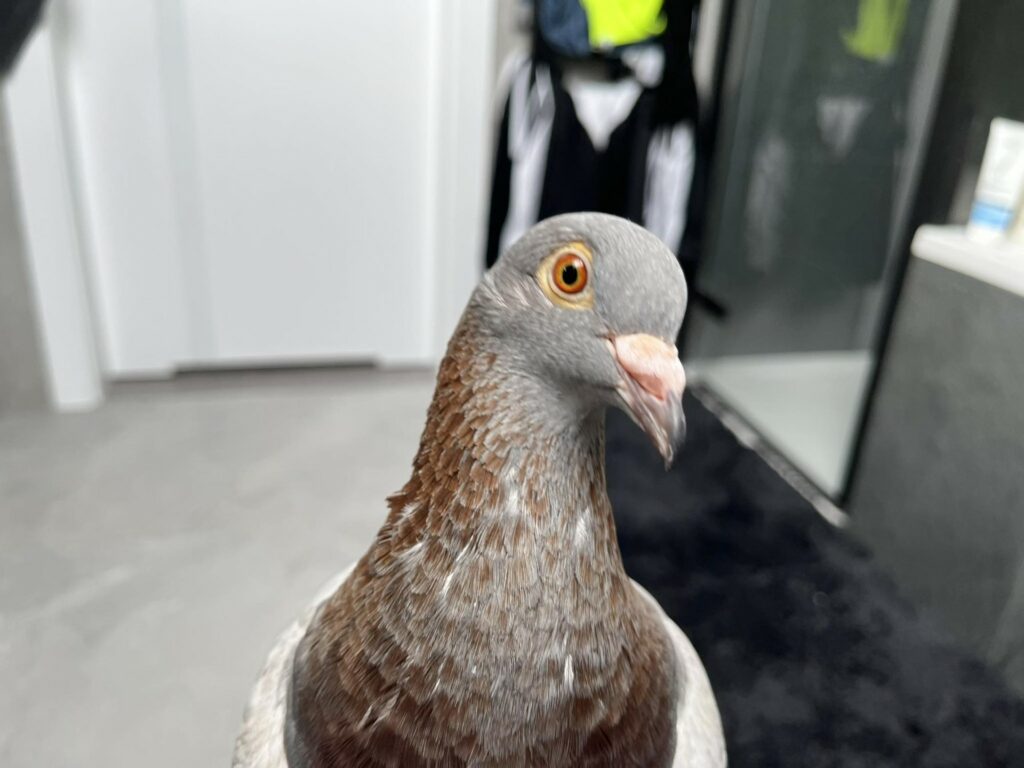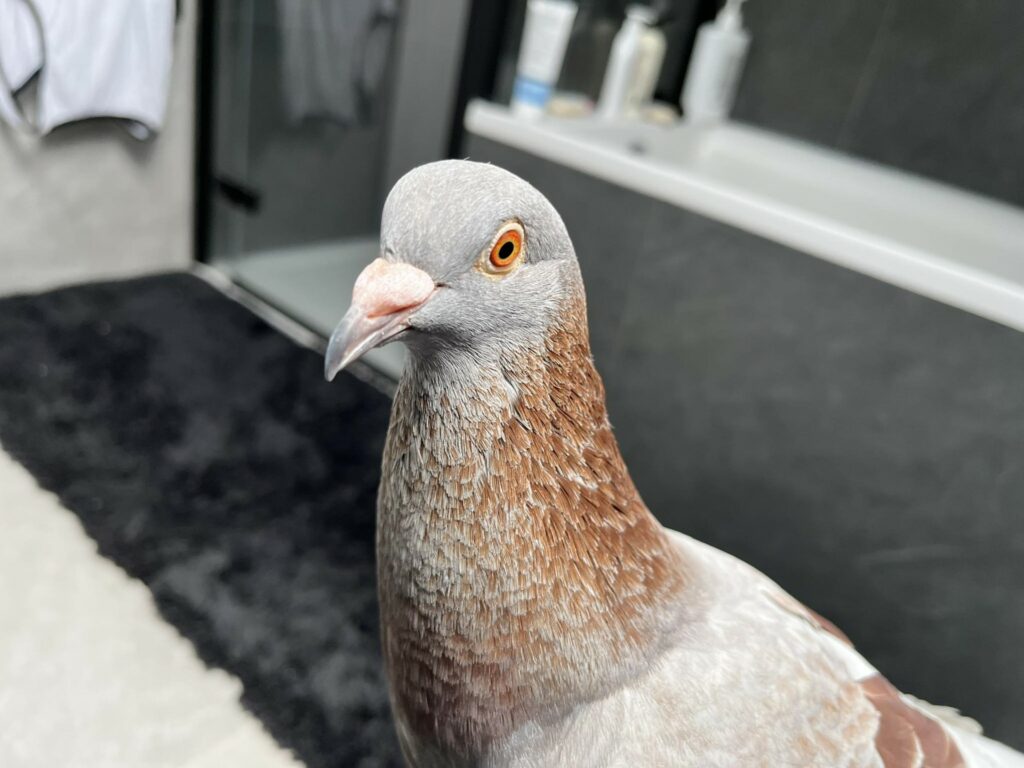White pigeons have always captured our attention and imagination. From ancient stories to modern movies, these beautiful birds often pop up, making many of us wonder about their significance. Are they just pretty birds? Or do they carry a deeper meaning? Throughout history, people from different cultures and backgrounds have given special meanings to white pigeons. Some see them as symbols of peace, while others believe they carry messages from the heavens.
In this article, we’ll take a journey to discover what a white pigeon really means and why it holds such a special place in the hearts of many. So, whether you’ve seen one recently and are curious, or simply love a good story, read on to unravel the mystery of the white pigeon.

What Does a White Pigeon Mean?
Historical Significance of the White Pigeon
The white pigeon, with its graceful form and pristine hue, has a rich tapestry of history woven around it. As we travel back in time, the bird’s symbolism and significance take root in ancient civilizations, manifesting in tales of gods and deities. Its divine association also extends into religious contexts, serving as emblematic references in sacred scriptures and rituals.
Ancient civilizations and their interpretation
White pigeons and doves have graced the legends and myths of ancient societies. Their tales depict a fascinating blend of divine associations, earthly desires, and human endeavors.
- Roman interpretations and Venus
In Roman mythology, the white pigeon (or dove) was closely associated with Venus, the goddess of love, beauty, and fertility. Venus was often depicted riding a chariot drawn by doves. These birds, in their purity and grace, symbolized the divine beauty and love that Venus stood for. As messengers of Venus, white pigeons also became symbols of love messages or romantic epistles in the ancient Roman world.
- Greek stories and white doves
The ancient Greeks had their own stories surrounding white doves. Aphrodite, the Greek counterpart of Venus, was said to have been born from the sea foam and reached the shore by drifting on a shell, escorted by white doves. These doves, for the Greeks, symbolized love, purity, and harmony. They were also considered messengers between the mortal realm and the divine, bridging the gap between gods and humans.

White pigeons in religious contexts
The symbolism of the white pigeon transcends beyond ancient myths and finds deep-rooted significance in various religious traditions. These birds have often been seen as emissaries of divine messages, embodiments of peace, or manifestations of the divine.
- Christianity and the Holy Spirit
In Christian iconography, the white dove is a powerful symbol of the Holy Spirit. One of the most significant references can be found in the New Testament, during the baptism of Jesus. As Jesus emerges from the water, the Holy Spirit is described as descending upon Him “like a dove.” This moment cemented the white dove’s association with purity, peace, and divine guidance in Christian teachings.
- Judaism and peace offerings
In Jewish traditions, doves and pigeons were often used as offerings in the temple. Specifically, they were regarded as symbols of peace and atonement. When Noah sent out a dove from the Ark to see if the floodwaters had receded, it returned with an olive branch. This gesture is one of the earliest biblical references to the dove as a symbol of peace and hope.
- Other religious references
White pigeons and doves find mentions in other religious contexts as well. For instance, in Islamic traditions, the dove is sometimes regarded as a messenger or a creature that communicates with prophets. In Hinduism, Kamadeva, the god of love, has a flag emblem with a dove depicted on it, signifying love and compassion. These varied interpretations across different religions highlight the universal reverence and significance attributed to the white pigeon.
The White Pigeon as a Symbol of Peace
Across time and cultures, the white pigeon has gracefully flown as a universal emblem of peace. Its pure hue and gentle demeanor resonate with a hope for tranquillity and an end to strife. But how did this bird become such a powerful and universal symbol? Let’s delve into its history and modern applications.
The story of Noah’s Ark and its role in establishing this symbolism
One of the most ancient and foundational tales establishing the white pigeon, or dove, as a symbol of peace is found in the biblical story of Noah’s Ark. After the Great Flood, as the waters began to recede, Noah sent out a dove to gauge whether land had emerged. The dove returned once without any sign, but on its second venture, it brought back an olive branch. This act signified not only that the waters had receded but also heralded a message of hope, reconciliation, and new beginnings. The olive branch and the dove jointly became potent symbols of peace, a promise from the divine that such a catastrophic deluge would not occur again.
Check my article about Are Doves Pigeons?
Modern use in peace movements and demonstrations
In more recent times, the white pigeon’s association with peace has been rejuvenated and adopted by various peace movements around the globe. During significant anti-war protests, civil rights movements, and calls for disarmament, releasing white pigeons has become a poignant gesture, symbolizing a collective yearning for peace and harmony. This act resonates with onlookers, bridging cultural and linguistic divides, and conveying a clear, powerful message against violence and strife.
White pigeons in disarmament and treaty ceremonies
In the world of diplomacy and international relations, symbols carry weight. The white pigeon has found its place in the solemn ceremonies of disarmament and treaty signings. These birds, often released during these events, serve as a visual representation of the hope that conflicts can be resolved, weapons can be laid down, and nations can coexist harmoniously. Their flight symbolizes a soaring aspiration towards a world where dialogue replaces conflict and where understanding supersedes hostility.

Cultural Interpretations of the White Pigeon
The white pigeon, much like a traveler, has journeyed across diverse cultures and has been cradled in their tales and traditions. Each region has bestowed upon it unique interpretations, yet the underlying reverence remains consistent. Let’s embark on a journey to understand the myriad tales associated with this majestic bird.
Eastern interpretations
- White pigeons in Chinese legends and fables
In Chinese culture, white pigeons often symbolize longevity and eternal love. Tales and fables recount stories of lovers transformed into doves so that they can stay together forever, undivided by life’s adversities. - Japanese tales and the purity of heart
Japanese folklore and tales carry a deep appreciation for the white pigeon’s symbolism. Here, they often represent purity of heart and fidelity. In certain tales, they act as messengers or guides, leading protagonists to their destinies or delivering important messages between separated lovers.
Native American tales about white pigeons
Native American tales offer a rich tapestry of stories and interpretations about white pigeons. In many tribes, they are seen as messengers between the earth and the spirit realm. Their appearance in dreams or during significant events can be interpreted as signs or omens, often carrying messages of hope, peace, or guidance from ancestors and the spirit world.
African and Middle Eastern stories
- Africa
African folklore, diverse as the continent itself, often positions the white pigeon as a symbol of communication and community. In some tribes, the pigeon’s cooing is believed to carry messages from departed souls, offering comfort and wisdom to the living. - Middle East
In Middle Eastern tales, white pigeons often interweave with stories of love and loss. They are seen as carriers of souls, bearing them safely to the afterlife. Their pure color also associates them with themes of innocence and the divine, often appearing in stories as omens or bearers of hopeful tidings.

White Pigeons in Pop Culture and Modernity
The cultural and historical significance of white pigeons seamlessly integrates into modern expressions and mediums. Whether it’s in movies, songs, or art, the white pigeon continues to soar, signifying peace, love, and transcendence. Here’s how the bird flutters within the realms of pop culture and contemporary expression.
Film, music, and literature
- Film: White pigeons have graced the silver screen in many iconic scenes. Whether symbolizing a moment of revelation, a message delivery, or signifying hope amid chaos, their presence adds depth and emotional resonance to cinematic narratives.
- Music: Songs across genres have metaphorically employed white pigeons to convey messages of peace, love, or longing. Their gentle cooing sound has also been used in tracks, adding an ambient, peaceful undertone.
- Literature: Poets and novelists have long been enamored by the white pigeon’s mystique. From symbolizing undying love in romantic prose to representing freedom in socio-political narratives, the bird has been a recurrent motif in literary landscapes.
Commercial symbolism: Brands and logos
- The purity and universal understanding of peace associated with white pigeons have made them a popular choice for branding and logos. Companies aiming to convey trust, peace, and harmony often employ the imagery of a white pigeon in flight or holding an olive branch.
- Notably, several non-profit organizations, especially those focusing on peace initiatives or conflict resolutions, utilize white pigeon imagery to reinforce their mission and values.
Art installations and public art pieces
- Modern artists, always in search of symbols that evoke emotion and resonance, have frequently turned to the white pigeon. In public squares, parks, and galleries, one might come across sculptures, murals, or interactive installations featuring white pigeons.
- These art pieces, often laden with commentary on contemporary issues like war, migration, or unity, leverage the white pigeon’s historic symbolism to communicate powerful messages, invoking introspection and dialogue among viewers.

The Biological Perspective
While the white pigeon’s symbolic significance is vast and varied, understanding its biological aspect provides an intriguing lens through which we can view this bird.
Natural occurrence of white pigeons: Albinism vs. true white
White pigeons can be naturally occurring due to two primary reasons: albinism or being true white. Albinism in pigeons is a genetic condition where the bird lacks the pigment melanin, resulting in a completely white appearance along with red or pink eyes. On the other hand, true white pigeons possess white feathers due to their genetic makeup but will have the standard colored eyes, often a shade of orange or brown. Differentiating between an albino and a true white pigeon usually boils down to the color of their eyes.
Breeding and domestication: The role of humans in propagating white pigeons
Human intervention has played a considerable role in the proliferation of white pigeons. Through selective breeding, humans have been able to emphasize and reproduce the white coloration in pigeons over generations. Domestication of pigeons dates back thousands of years, and breeding them for specific traits, including their color, has been a longstanding practice. The demand for white pigeons, due to their aesthetic appeal and symbolic significance, has further spurred breeders to produce these birds in larger numbers.
Check my article about What Do Pigeons Symbolize?
Habitat and adaptation: Do white pigeons have different survival tactics?
In the wild, a pigeon’s color can play a significant role in its survival. Camouflage helps birds evade predators, and in many natural environments, a bright white pigeon might stand out, making it more vulnerable. However, in urban environments where pigeons have increasingly adapted to live, white pigeons might not be at a significant disadvantage since the threats of natural predators are reduced. It’s also worth noting that pigeons, regardless of their color, have developed a range of survival tactics, from foraging in groups to seeking shelter in human-made structures. The adaptability of these birds ensures that even the white pigeon, with its stark coloration, thrives in diverse habitats.
The White Pigeon in Personal Experience and Anecdotes
Beyond the broad strokes of history, culture, and biology, the white pigeon often finds its way into the intimate stories and experiences of individuals. It’s in these personal anecdotes that the bird’s magic truly comes to life, intertwining with human emotion and creating memories that last a lifetime.
White pigeons as omens or signs in personal stories
Many people across various cultures view the sudden appearance of a white pigeon as an omen or sign. For some, a white pigeon landing on their balcony or window could signify an impending message or visit from a loved one. For others, it could be an omen of peace and positive change coming into their lives after a turbulent period. The personal stories revolving around these encounters often carry a spiritual undertone, wherein the bird is seen as a messenger bridging the mortal and the divine.
Marriage and other ceremonies: White pigeons as bearers of joy
One of the most cherished customs in many weddings around the world involves releasing white pigeons. Symbolizing love, unity, and a new beginning, the act of watching these birds soar into the sky adds a touch of magic to the occasion. Beyond weddings, white pigeons are often released during significant ceremonies, such as milestone anniversaries or memorial services, where they stand as bearers of joy, hope, and remembrance.
Personal encounters: Shared stories from around the world
People from different corners of the world have their unique tales about white pigeons. In some stories, a lone white pigeon might have provided company to someone in isolation. In others, a flock of these birds might have appeared during a significant life event, amplifying the moment’s emotion. Whether it’s a traveler in Europe recounting how a white pigeon led him to a hidden scenic spot or a grandmother in Asia sharing tales of a pigeon that visited her every day, these personal encounters weave a beautiful tapestry of shared human experiences, elevating the white pigeon from mere bird to a cherished companion in life’s journey.
Check my article about Do Pigeons Mate For Life?
What Does a White Pigeon Mean? Final Thoughts
The white pigeon, with its graceful flight and resplendent hue, has always been more than just a bird. Its journey through time, cultures, and personal tales is a testament to its enduring significance in human history and emotion. From ancient myths to modern pop culture, from biological curiosities to cherished personal encounters, the white pigeon has effortlessly bridged divides, carrying messages of peace, love, and hope.
As we reflect on its multifaceted role, it becomes evident that the allure of the white pigeon lies in its simplicity and universality. Whether seen as an omen, a messenger, or a symbol of peace, it reminds us of our shared human experiences and aspirations. In a rapidly changing world, the timeless symbolism of the white pigeon serves as a beacon, urging us to cherish moments of peace, unity, and understanding. Whether you’ve personally felt its magic or are only now discovering its stories, one thing remains clear: the white pigeon’s legacy will continue to soar, etching its mark on the hearts and tales of generations to come.
What is the historical significance of a white pigeon in ancient civilizations?
In ancient civilizations, such as the Romans and Greeks, white pigeons or doves were associated with deities like Venus and Aphrodite. They symbolized love, beauty, and other divine attributes.
How is the white pigeon viewed in religious contexts?
Many religions regard the white pigeon as a symbol of peace and divine messages. For instance, in Christianity, the white dove represents the Holy Spirit. In Judaism, doves were often used as peace offerings.
Why is the white pigeon often seen as a symbol of peace?
One of the foundational stories comes from the biblical tale of Noah’s Ark, where a dove returned with an olive branch, signifying peace and God’s promise of never flooding the Earth again.
How do Eastern cultures interpret the appearance of a white pigeon?
Eastern cultures, such as the Chinese, view white pigeons as symbols of eternal love and longevity. In Japan, they often signify purity of heart and fidelity.
How have Native American cultures perceived white pigeons?
In Native American lore, white pigeons are often seen as messengers between the earthly and spiritual realms, carrying omens or messages from the ancestors.
Do white pigeons have a place in modern pop culture?
Absolutely! White pigeons have made appearances in film, music, literature, and even brand logos, often symbolizing peace, love, or messages.
From a biological perspective, what causes the white coloration in pigeons?
White pigeons can either be a result of albinism, where the bird lacks melanin, or they can be true white pigeons, which possess white feathers due to their genetic makeup but have standard colored eyes.
Are white pigeons released during ceremonies worldwide?
Yes, releasing white pigeons during ceremonies like weddings is a global custom, symbolizing love, unity, new beginnings, and hope.
How do people perceive personal encounters with white pigeons?
Many individuals view spontaneous encounters with white pigeons as omens or signs. These birds are often associated with impending messages, positive changes, or spiritual connections in personal anecdotes.
What’s the core message behind the symbolism of a white pigeon?
At its heart, the white pigeon universally stands for peace, hope, and love. Whether it’s through ancient tales, religious beliefs, or personal encounters, the bird consistently symbolizes unity, understanding, and positive messages.




